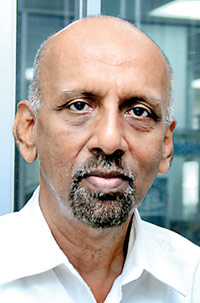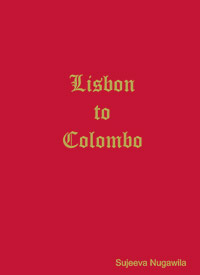A love for history takes him in search of a language legacy

Sujeeva Nugawila
It was a long-lost love that he has been able to rekindle, which has now taken the form of a book…and it is no ordinary book but one that has dived deep into the past to place under scrutiny numerous words that are very much a part of daily use in Sri Lanka.
For Sujeeva Nugawila, it has somewhat been like ‘parangiya kotte giya wage’ (like the Portuguese went to Kotte). The journey has been arduous and time-consuming but the culmination is ‘Lisbon to Colombo – A Study of Portuguese sounding words in the Sinhala Language’.
A few examples of such words flow forth from Sujeeva before he relives how his interest in the two languages was aroused. “Think of ‘estreieya’, the formal Sinhala reference to a female and just twist your tongue against ‘De estreia’ which in Portuguese means ‘maiden’,” he says, rattling off others as well without a glance at his book.
Oft-heard these days in the country is ‘paga’ (bribery) and Sujeeva elaborates that the Portuguese used this word to mean ‘pay up’ or ‘pay for’ possibly in seeking permission or taxation.
Whether it is about food or water, roads or homes, bridges or musical instruments and many more, there seems to be a strong link between Sinhala and Portuguese, the latter, the language of the first colonisers of Ceylon way back in the 16th century. Ceylon’s coastal folk would have heard it over and over again for around 150 years.
‘Para’ in Portuguese is ‘towards’ and is similar to the Sinhala word ‘paara’ meaning ‘road’, while ‘passagem’ (gangway) in Portuguese seems close to the Sinhala word ‘pallang’ (bridge), he says, adding that the Portuguese refer to paste/sticky/gum/starch as ‘goma’, while the Sinhalese daub a mixture of ground clay and cow dung with the same name on the walls and floor of dwellings.
Delving further, into accommodation, he points out that ‘buraco/arquivar’ in Portuguese means ‘pigeon hole’ and could be linked to ‘muddukku (wa)’ (shanties) in Sinhala.
This is while the Portuguese “lounge” in a ‘vadiar’ and traditional fishing communities in Sri Lanka make transit-stops at open-air shelters known as ‘vadier’ (wadiya).
Do the fishermen survive on ‘suudaya’ also known as the white sardine, while the Portuguese feast on ‘sardinha’ or is this a meal of the humble ‘cigano’ as gypsies are dubbed by the Portuguese and the ‘singanno’ as beggars are known in Sinhala?
Of course, there would be no fish or meat, only vegetables consumed on the trek up Sri Pada for pilgrims traditionally led by a ‘nade gurra’, while the Portuguese called their leaders ‘guia’.
There would also be no crawling or dragging of feet as in ‘arrastado/a’ in Portuguese on such pilgrimages as there would also be no hangers-on or ‘rasthiyadu(karayas)’ as derogatorily referred to in Sinhala.
It is not different like chalk and cheese but similar to chalk and milk, according to Sujeeva who says that ‘cre’ in Portuguese is chalk, while milk in Sinhala is ‘kiri’ and could be an inference to the colour of chalk.
The colour white is also known as ‘kiri parta’. Going into ‘liquid carriers’, he indicates that the ‘penico’ (chamber pot) in Portuguese could very well be the source for the Sinhala ‘panittu’ (metal water bucket).
Hospitals, anatomy and diseases come in quick succession – ‘espreitarse’ in Portuguese means ‘to take care of’, with colloquial Sinhala referring to a hospital as ‘espirithale’; ‘volver’ in Portuguese means to turn (as the eyes or face) while in colloquial Sinhala ‘oluver’ means head; the Portuguese refer to the ‘crown of the head’ as ‘päte’ while a bald pate is called ‘thatte’ in Sinhala; the Portuguese word ‘chuva’ means ‘waterway/waterfall’ and urine is referred to in colloquial Sinhala as ‘choo’; while ‘estalar’ means sputter in Portuguese and ‘kellar’ in Sinhala is saliva.
‘Papole’ in Portuguese is wart and ‘papol’ in Sinhala is chickenpox, says Sujeeva, laughingly adding that ‘bizarro’ is kinky, odd and grotesque in Portuguese, as ‘vikkarra’ in Sinhala connotes erratic behaviour.
Referring to sounds, he points out how the Portuguese call gunshots ‘de tiro’ and the Sinhalese link thunder with ‘dedera’ with the Portuguese calling the accordion a ‘sanfona’ while the Sinhala word for a ‘table model with a wind-assisted manual keyboard’ is ‘sarpina’.
No one cared a ‘tu’tu’, the Portuguese reference to trivial things, echoed in Sinhala with ‘thuttu’ (the archaeological meaning being ‘a coin of very low value used in the late Portuguese-early Dutch period’) for his passion for history when he was still a boy, attending St. Joseph’s College, Colombo, Sujeeva recalls.
It only drew ire from his parents who wanted him to fit into the stereotypical and follow a discipline such medicine or engineering and not dwell on things of the past.
“The opportunities to pursue higher studies in history were limited and even my pleas for books on history were turned down,” he sighs, thinking of all those lost years.
Even when he left school and took up duties as a manager at SriLankan Airlines Catering based at the airport for 33 long years, an indulgence in history was not possible what with the heavy workload.
The “break” into his yearning, dormant for a very long time, came when he migrated to Orange County in southern California in the United States of America a few years ago with wife Rosemary and daughter Sajeeni.
As his pathway crossed a large number of people of Mexican origin, he would hear the common greeting ‘comoesta’ which meant ‘How are you?’ His ears also picked up swear words spewed forth in rage, which seemed very familiar. “They were like the rank filth and obscenities we would hear in quarrels in slum areas back home,” he laughs.
Book facts Lisbon to Colombo – A study of Portuguese sounding words in the Sinhala language, by Sujeeva Nugawila |
There seemed to be a common link and Sujeeva headed to the library. Day in, day out, while he pored over Portuguese dictionaries, a friendship too blossomed with Brazilian journalist Yara De Oliveira who promised him more dictionaries from Brazil whenever she went home. “This was the foundation on which I built up the book,” says Sujeeva, whose sister too would order books on e-bay for him.
Long hours he spent at the library and when it put up its shutters for the night, heavy would be the tomes he carried back home with him to burn the midnight oil to the consternation of his wife and daughter.
The reference books he studied in the library while one dictionary which he could take home, he kept for two years extending the handover date often.
What started off as a hobby had developed into a passion. “I didn’t realize what depth I would have to get into,” he says, adding that initially he thought there were about 100 Portuguese words as part of the Sinhala language, realizing the enormity of the integration only gradually.
Those 100 words are directly from Portuguese without a change in the sound but he has come across around 2,000 words in the Sinhala language which are from Portuguese but with “slight twists” in the sound.
Flipping through the pages of his book, Sujeeva is quick to point out that he has not gone into phonetics as the reader would get confused and no one knows how to pronounce them.
Fourteen sections his book has with detailed descriptions on the links between Portuguese and Sinhala. However, he has scrupulously avoided those evocative swear-words which amount to about 40.
‘Lisbon to Colombo’ priced at Rs. 1,000, encompassing within its pages the language legacy of the Portuguese, is available at Lake House and Sarasavi Bookshops. (The author may be contacted on: sujeevanugawila@gmail.com)


